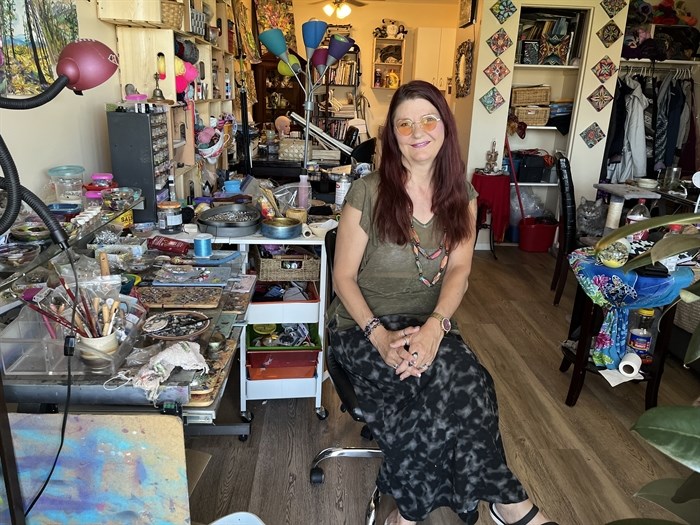Kamloops woman relies on community, art sales to survive on disability income

Karla Pearce sits on a chair in her small apartment suite surrounded by cupboards stuffed with art supplies and walls that are bursting with colourful art. The door to her tiny deck is open and a warm breeze blows through. A furry grey cat tiptoes around her.
“Cupboards and closets have to have doors off so I can see everything,” she said. “I have no long or short term memory and will forget where I put things.”
Pearce is a well-known artist and resident in Kamloops who has bipolar disorder, a lifelong condition that limits her ability to work full time. She’s learned how to survive, and often thrive, on a meagre disability income since getting her formal diagnosis four years ago, but it isn’t easy.
“Having disability insurance helps pay for rent, my lifesaving meds and generous portions of related medical costs,” she said. “It doesn’t cover bills or a vehicle or gas, and it doesn’t cover groceries.”
This leaves Pearce with just under $200 per month after the bills are paid. She said the number one way for people on disability to survive financially, to avoid homelessness, is to get a part time job if they are able.
“In the summers I sell art at farmers' markets and in the winters I read tarot cards at coffee shops,” she said. “Even an extra $40 a week allows me to get necessities. I’ve seen some very disabled people working, I think our society accepts that.”
As a single person on disability she can earn up to $15,000 dollars a year before her earnings affect her disability income.
“They are trying to bring you up,” she said. “Being on disability gives you all that medical help and access and then you can get better and live a better life, and in theory get a part time job here and there.”
READ MORE: Why homelessness will only get worse in the Okanagan, Kamloops
Another key to her survival is being a part of a community and having the ability to voice her needs.
“I have friends and family and people that love me here,” she said. “Before this place I was in a situationship where you’re sleeping with someone, doling out sex so you have a place to live. Then that went bad and I was homeless again. Three nice men helped me get this place in response to a post I made on social media. You can’t allow yourself to get too isolated, you stay in touch with other people.”
She said the community is needed to prevent people from going into a crisis state and ending up on the street.
“Disabled people are very vulnerable, they will get preyed on, and with the system, if you’re not vocal about your needs, if you have a disability that makes it hard to talk to people, you don’t get the help or you’re put into a crack shack.”
Pearce has learned ways to scrimp and save. She depends on the food bank to get her through year round, but the winter season can be meagre and the food not nutritionally varied enough. She “hibernates” in the winter to save costs and energy, except when she is doing tarot readings in cafes where she tops up on milk and sugar in her coffees to get calories.
“In the winter you get pasta, rice, bread, apples and potatoes, there isn’t enough protein so I lose weight,” she said. “The veggies are already turning so if you get some you eat them right away and if you get brown bananas you stick them in the freezer for smoothies.”
READ MORE: Kelowna wants to create more affordable housing but will wait for more studies
While Pearce is “so grateful” to be living on her own with community support and the ability to work on the side, she said the system is far from perfect for many others.
“On disability you get lots of stuff, like glasses but the whole cost isn’t covered. I can save up for things because I’m able to work,” she said. “There are incredibly vulnerable people who have major mobility issues or serious handicaps that can’t do that. There is not enough money to live on, the community has to pick up.”
She said if the government could give another $1,000 per month, it would give disabled people enough to cover rent and help them avoid “life-threatening homelessness.”
“It would probably ease the homelessness and drug addictions and the pain people are going through,” she said. “Without four walls and a roof, you’re screwed. Some people falling through the cracks are severely disabled or on drugs, which is like a disability, and it’s hard to get back up when you’re angry, tired and stressed all the time. Being disabled shouldn’t be a life sentence of poverty.”
READ MORE: Rec centres or affordable housing? Kelowna council needs to get its priorities straight: builder
Pearce worked in media in Kamloops in the past and had an art gallery. She was once an art teacher but suffered mental collapses and other effects like memory loss and migraines from a lifetime of living with bipolar disorder.
This is the first time she has been able to live independently.
“So far this is the best time of my life, I’m very blessed to live here,” she said.
Last year Pearce burned her paintings in an effort to raise awareness for disability payments that have not increased along with the cost of living in BC.
“How we look after our most vulnerable people as a society, if we leave them on the street to die, that’s telling us who we are."
In 2021-22, there was an average of just over 115,800 cases in British Columbia’s Disability Assistance program, and nearly 140,700 beneficiaries that include individual claimants, their partners, and dependent children according to Maytree social assistance summaries. Both numbers have been steadily rising over the last 26 years, with the vast majority being unattached singles.
People with disabilities are defined as being at least 18 years old with severe physical or mental impairment that is expected to continue for at least two years, and who are restricted in performing daily activities or require assistance with daily life, according to the BC Employment and Assistance for Persons with Disabilities Act. Also included are those with episodic illnesses that restrict daily living activities either continuously or periodically for extended periods of time.
The province recognizes some people with disabilities need additional supports through financial assistance, annual earnings exemptions, supplementary assistance and specialized employment supports.
Once individuals qualify for disability assistance they keep their Persons with Disabilities designation, and after they leave assistance for employment or other income support programs, they can maintain their medical assistance.
— This article was updated at 10:45 a.m. Wednesday, May 31, 2023, to correct the amount a single person on disability can earn before earnings affect disability income.
To contact a reporter for this story, email Shannon Ainslie or call 250-819-6089 or email the editor. You can also submit photos, videos or news tips to the newsroom and be entered to win a monthly prize draw.
We welcome your comments and opinions on our stories but play nice. We won't censor or delete comments unless they contain off-topic statements or links, unnecessary vulgarity, false facts, spam or obviously fake profiles. If you have any concerns about what you see in comments, email the editor in the link above.



